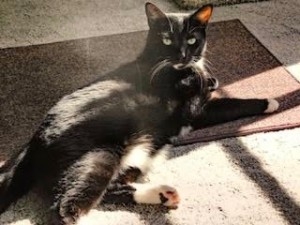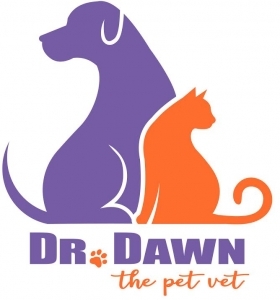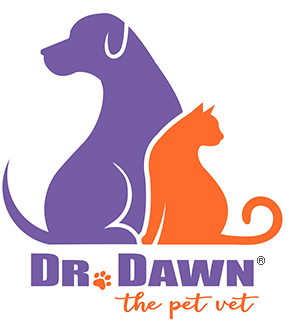
A large number of my patients are senior. Their families face the same questions that I have asked myself , and we all may eventually ask, which is whether our older dogs or cats are suffering from senility, or dementia. It is important to know whether what they are doing reflects physical or emotional pain, is abnormal aging, or if it can be treated to help improve their quality of life. Living with older pets can be a challenge, but I think knowledge can empower you to help give them their best lives.
As pets live longer, their behavior may change, acting as if ” they forgot their training” or “their personality has completely changed”. Many are actually suffering from a condition that we call canine cognitive dysfunction (CCD), or feline cognitive dysfunction (FCD). There are many similarities, particularly in dogs, to human Alzheimer’s disease, and dementia. There are specific things to look for, and that can be done, to ease this process of aging.
Human medicine has a DSM referencing system that categorizes psychiatric conditions. CCD, also considered canine Alzheimer’s disease, can be diagnosed by its veterinary equivalent and acronym listing signs of this condition, DISHA, or DISHAA, depending on your source.
That stands for:
D for Disorientation
I for altered social Interactions
S for Sleep disturbance ( or sleep-wake cycle alterations)
H for House soiling
A for altered Activity level
A for Anxiety

So often, people think that their pet is just getting older, and they may not think to mention insidious changes in their activity or behavior when seen at the veterinarian. And, if a client is only being seen once a year, or for an illness, it may get missed in the face of a more urgent condition. Thus, it is important to see older patients more frequently, and to ask specific questions to see if a patient has CCD or FCD. While there is no cure, there are ways to intervene and lessen the symptoms, and improve the cognitive functioning and quality of life of the pet, and the family living with the pet.
So, think about whether your pet seems at all, at times, disoriented? Sometimes they are not just having trouble hearing, but are confused and unaware of their surroundings. You might notice them being irritable, antsy, or clingy.
If they no longer seem to get joy out of spending time with family members, sleep more, are less inclined to go on walks that they used to love, or , say, no longer come to you for their nightly belly rub. Such changes in social interactions may be a clue.
Many patients pace through the night, often keeping clients awake. In fact, this is the most common reason I am called to examine an elderly pet. It is more often the first hint that leads to other questions, helping us determine that there are several cognitive issues at hand, albeit less obvious. Often, a large breed arthritic dog that paces at night is assumed to be in pain and uncomfortable, thus getting up and moving at night. But sometimes there is more to the story.

House soiling is another common reason that clients contact veterinarians, particularly in a previously trained dog or cat. They may go outside or into the litter box to urinate or defecate, and then come back, and defecate or urinate in the home, seemingly oblivious. And the lack of knowledge that they did it is also a sign of dementia. At house calls, I see many older dogs confined to crates for much of the day, as a result, which is a disheartening reality for many older dogs.
Anxiety is sometimes harder to pick up, but a dog or cat that is reluctant for you to leave them, sits by your side more than they did in the past, or is bothered by noises or changes in their routine, when the behavior wasn’t seen before, can indicate anxiety. A less active pet is chalked up to old age, but again, may be due to a lack of interest in activities, or a physical inability to do so. Important to distinguish and treat appropriately if possible.
So often, I am asked to determine the quality of life of a patient. This list of symptoms above is a mental checklist all pet parents should go through, to help them think about their pet, and how to better answer the questions a veterinarian will have for them when asked to assess life quality.
So, if you and your veterinarian have decided that there is a cognitive issue, what can be done?
Supplements:
Antioxidants such as Vitamins E, C and A have been shown to help. There are also cognitive fatty acid supplements that I recommend. The medium-chain triglycerides have been shown to help cognitive performance. And, L-carnitine supplementation helps muscle maintenance. This is important, as patients that are elderly also have metabolic issues, such as kidney or liver dysfunction, resulting in quicker loss of muscle mass. Combined with less activity, they develop muscle atrophy at an expedited rate, making them not only seem frailer and “older” in appearance, but making them more dependent on their often arthritic joints even more for weight bearing. L-carnitine also has neuroprotective effects. Proper amino acid supplementation, or that provided in a diet (see below) for senior pets is an easier way to support this muscle mass.
Coenzyme Q10 (CoQ10) is another antioxidant shown to boost cellular energy production.
Blueberries contain antioxidant flavonoids, which also cannot hurt and are a commonly recommended healthy, low calorie treat I recommend for my elderly patients.
Diets:
I recommend are Hill’s Prescription diet B/D. I like this #diet and recommend it first. If they don’t like it, then supplementation of separate ingredients is the other option.
Non-prescription options include Purina Pro Plan NeuroCare diet, and Purina Pro Plan’s Bright Mind diet.
Medication:
Nighttime wandering and pacing are helped with anti-anxiety or sedating medications. I have many older dogs and some cats on gabapentin, which helps relax them, and mask signs of pain. While we cannot prove it relieves pain, the effect has been compared to “having a glass of wine”, and helps in the daytime as well. I have older anxious patients that are bothered by nighttime noises, and they take Xanax, which is a benzodiazepine. Other doctors prefer sedatives like Trazodone, which I sometimes prescribe. The issue with benzodiazepines is that, while helping with anxiety, they may hasten the cognitive decline in human patients. Still, with our pet patients, when quality of life is prioritized over quantity, this is often an option that works for all in the household. Same goes for serotonin reuptake inhibitors (SSRI’s) for moderate anxiety. They need to be given daily, not on an as needed basis, and thus are a commitment discussed at length prior to going down that path of treatment.
There is a drug called selegiline (Anipryl), with which I have had mixed results. It is marketed for CCD, and is a monoamine oxidase inhibitor (MAOI). It is an antidepressant that alters consciousness and mood. It has been shown that human Alzheimer’s patients have a lack of dopamine (human drug name is Elderpryl). Thus, this drug, by increasing dopamine in the system, has been shown to decrease some signs of the disease in dogs. Recent studies have shown that between 1/3 and 2/3 of canine patients given the drug showed some improvement. When I do use this drug, I tend to use it alone, as it can result in side effects when used in combination with other drugs. So often, my elderly patients are on other drugs already, and thus the clients are reluctant to remove something that seems to help some symptoms, and risk another.
And, in lieu of sedatives, some clients are more comfortable trying melatonin to aid in nighttime sleep issues. It often helps my patients, and has antioxidant properties. In some studies, it has been shown to increase lifespan in experimental animals.
In addition to arthritis oral medications, there are two new products that address pain with an injection, with extremely promising results. Both are monoclonal antibodies, Librela for dogs, and Solensia for cats. Ask your veterinarian if this is right for your pet.
Home environment enrichment:
Lastly, check out the environment that your pet lives in. Is he or she forced to climb stairs to get to bed? Is the lid on the litter box too high for her to climb into? Is there a cozy perch or cushioned bed for them to rest upon? Is the home too loud or busy at times of the day, and is there a place they can escape to in hopes of avoiding that activity?
Aromatherapy, used carefully, or even pheromone therapy helps reduce anxiety in both dogs and cats. Adaptil dog spray and Feliway cat plug ins are great options to try. Playing relaxing music, or even white noise helps. Exercise, within reason, such as walks, stimulate both the body and the mind, as well as play time. Cats do extremely well when adjusted to the No Bowl feeding system, which is a puzzle type feeding system, described previously in other blogs. It provides stimulation and satisfies their hunting urge. Check it out here.

All of these options listed should be discussed with your veterinarian, and a personalized plan for you pet can be formulated. Hopefully this information will be a starting point in a discussion for you and your veterinarian.
Dr. Dawn
Please share and subscribe here



